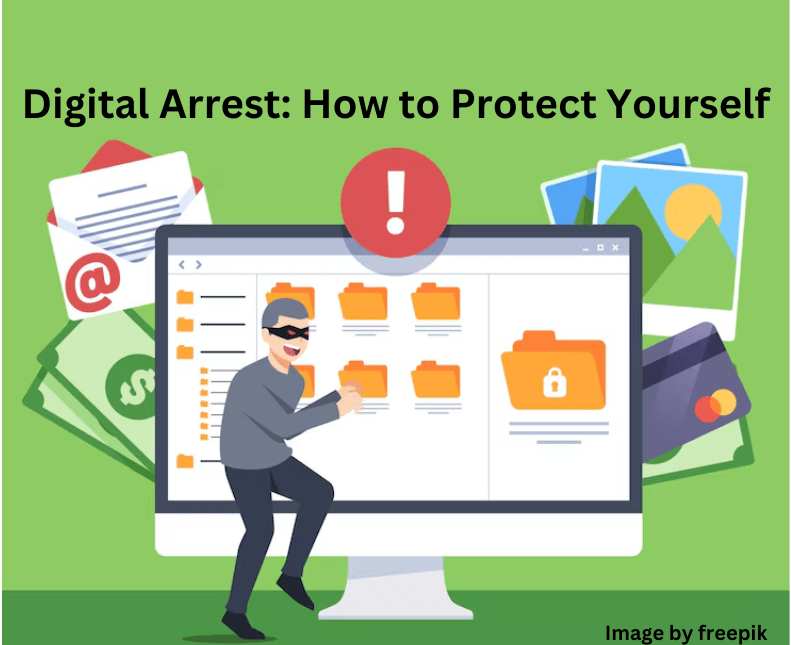“Digital Arrest” is a new form of cybercrime causing concern in India.
Recently, I received a call from a renowned courier company (supposedly) stating that customs had confiscated my package and I should share my Aadhar details to redeem the packet.
Of course, the Sherlock Holmes in me didn’t believe them, as I was confident that no one would send me a gift from abroad.
In the second case, a close relative received an email allegedly from “a government department” stating that he had been harassing a woman and should contact the undersigned within 30 days to avoid legal charges. The man’s well-wishers advised him to call the undersigned while I said, “Bring it on!”
It turns out nothing happened after 30 days, and another 30 followed by more 30 days.
These were my encounters with dodged ‘digital arrest.’ Let us understand this scam in detail and how to protect yourself from it.
Table of Contents
- Understanding Digital Arrest
- Steps Involved in Digital Arrest Scam
- Notable Examples
- Preventative Measures and Best Practices
- Future Implications and Legal Framework
Understanding Digital Arrest
It is an emerging cybercrime in which imposters pose as law enforcement and trick victims into believing their digital identities, such as bank accounts or Aadhaar cards, are misused. They then pressure these victims into transferring funds to escape the so-called ‘digital arrest,’ a scam that exploits the rapid digitization of our era.
This fraudulent activity involves the virtual arrest of individuals, limiting their access to digital platforms through deception. Sometimes, fraudsters use WhatsApp video calls for monitoring.
Be aware and protect yourself with adequate knowledge to surf safely in the digital world, keeping cybersecurity measures at the forefront to safeguard against such imposters and cybercrime tactics.
Steps Involved in Digital Arrest Scam
Here’s a breakdown of this cybercrime’s modus operandi:
- Initial Contact: The scam initiates with the scammer posing as a police officer, contacting the victim, and alleging involvement in a fictional money-laundering case. Victims are told they are under ‘digital arrest’ and must remain online, typically through Skype, to resolve the issue.
- Manipulation and Fear:
- They create a sense of fear and urgency, convincing the victim of their dire situation.
- They tell the victims about the illegal use of their bank accounts, SIM cards, or other personal identification.
- In some instances, victims receive interactive voice response (IVR) calls, further accusing them of criminal activities.
- Financial Exploitation:
- The ultimate goal of the scammer is to dupe the victim into transferring their savings or even applying for loans, which are then sent to the scammer’s account.
- Scammers employ psychological manipulation, using threatening language and false evidence to force significant payments from the victim, supposedly to avoid legal consequences.
Understanding these tactics is crucial for recognizing and protecting oneself from digital arrest scams. Awareness and vigilance are critical defenses against such cyber fraud.
Notable Examples
Several notable cases of digital fraud are emerging, highlighting the tactics of cybercriminals. Here are a few instances:
- Noida, Uttar Pradesh: A woman lost over ₹ 11 lakhs after scammers posing as police officials falsely implicated her in a money-laundering case.
- Faridabad, Haryana: A young woman faced a week-long digital arrest over alleged illegal use of her personal IDs, with fraudsters fabricating documents to support their claims.
These cases underline imposters’ diverse methods, from posing as law enforcement to fabricating legal documents to exploit victims. The urgency and fear instilled in victims led to significant financial losses, as seen in Faridabad, where a woman paid ₹ 2.5 lakh to avoid charges of passport trafficking.
Cyber police across four states have reported similar incidents, emphasizing the widespread nature of this scam. Awareness and vigilance become crucial in identifying and preventing such frauds.
Preventative Measures and Best Practices
To safeguard against these scams, adopting a proactive and informed approach to cybersecurity is essential. Here are some preventative measures and best practices:
1. Stay Vigilant and Verify:
- Always question the lawfulness of the caller and ask for official credentials.
- Double-check any claims made and request documents to back them up.
- Use official channels for any form of communication, avoiding unofficial or suspicious platforms.
2. Enhance Your Cyber Hygiene:
- Regularly update passwords and opt for two-factor authentication.
- Install and update reputable antivirus and anti-malware solutions.
- Use VPNs for encrypted internet connections and avoid public hotspots for financial transactions.
- Be cautious of phishing attempts; verify emails and messages before sharing personal information.
3. Educate and Stay Informed:
- Increase awareness about common cyber threats, especially those involving law enforcement impersonation.
- Keep abreast of the latest cybersecurity practices and encourage others to do the same.
- Familiarize yourself with the security features of your banking and online platforms, and regularly monitor accounts for unauthorized activities.
By incorporating these strategies, you can significantly reduce the risk of falling victim to digital arrest scams and other forms of cybercrime.
Future Implications and Legal Framework
Law enforcement authorities prioritize investigations to tackle this cybercrime effectively in response to the escalating threat of digital scams. Recognizing the sophisticated nature of these scams, the Indian government has introduced three important criminal laws to modernize the legal framework to fight cybercrimes more efficiently:
- Bharatiya Nyaya Sanhita, 2023 (New Penal Code): This code incorporates provisions for cybercrimes, including the controversial inclusion of ‘sedition’ under electronic communication. It also addresses the creation and spread of ‘false information,’ which could significantly impact social media and e-commerce platforms.
- Bharatiya Sakshya Adhiniyam 2023 (New Evidence Code) and Bharatiya Nagarik Suraksha Sanhita, 2023 (New Criminal Procedure Code): These codes facilitate the electronic registration of FIRs and mandate the virtual recording of seized property. They also grant law enforcement enhanced powers during investigations, such as the authority to seize electronic devices likely containing digital evidence.
Furthermore, the New Evidence Code equates electronic or digital records with physical documents in legal proceedings, recognizing electronic communications as documents. This move has profound implications for data protection and privacy, underscoring the need for individuals to stay informed and vigilant in safeguarding their digital identities.
Click here, and stay updated with the latest trends!
Q: What steps can I take to safeguard against cybercrime?
A: Regularly updated antivirus software can protect you from cybercrime. It provides a strong defense for your computer and personal data, offering peace of mind. Regular updates are crucial for maintaining the highest level of security.
Q: Could you explain what digital arrest fraud is?
A: Digital arrest fraud is a scam where perpetrators impersonate law enforcement officials and intimidate victims through video calls. An example includes a case where cyber scammers tricked a retired senior manager from Air India into believing a parcel of hers was seized at Mumbai airport, resulting in a financial loss of ₹35 lakh.
Q: Can you list ten strategies to prevent cybercrime?
A: To prevent cybercrime, consider the following ten strategies:
Keep your system updated.
Utilize a comprehensive internet security suite.
Ensure a secure internet connection.
Create strong passwords.
Stay vigilant against pop-ups and phishing emails.
Shield yourself from identity threats.
Adjust your social media privacy settings appropriately.
Obtain a suitable cyber insurance policy.
Q: What does the term’ cyber arrest’ mean?
A: ‘Cyber arrest,’ as defined by the Delhi Police, is a scam where fraudsters pose as law enforcement officials and convince victims that their bank account, SIM card, Aadhaar card, or other financial cards have been involved in illegal activities, thereby defrauding them.



